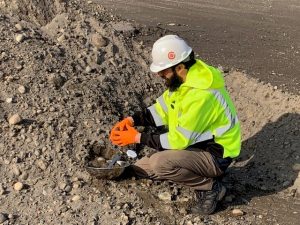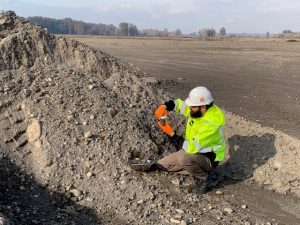Fieldwork with Phil: Putting dirt back to work
The construction process is a complicated web of decision making, preparation, testing and precision. In our blog on ground stabilization, we discussed the importance of establishing a solid foundation to build upon. In this edition of Fieldwork with Phil, port environmental specialist Phillip Martello gives us a look at a different side of dirt – fill soil.

Phillip Martello, port Environmental Specialist, collects soil samples in accordance with the port’s ‘fill acceptance protocol’
Fill soil is used to level out or bring a project area up to a set ground height. Not widely known, fill soil is an expensive commodity with numerous varieties and compounds – all of which need to match the specific technical requirements of a project.
Keeping our environment healthy is an integral part of the process. The port’s ‘fill acceptance protocol’ is in place so that any material the port plans to use as fill material is tested and screened to prevent inadvertent contamination of port property.
The port not only tests soils from off-site fill material, but also tests soils it intends to move from one area of the port to another. According to the protocol, the port’s environmental team samples the area or stockpile before any soil is disturbed and tests for a wide range of substances, including heavy metals, hydrocarbons and PCBs. The number of samples taken from the area is dictated by the amount of material that is planned to be excavated.
“We protect port property by having a strict sampling protocol,” said Martello. “Sampling allows us to be proactive in preventing contamination, reducing cleanups and responding quickly if contamination is discovered.”

If off-site fill soil fails to meet the port’s criteria, it is rejected for use on port property. If testing on port property reveals contamination, the appropriate steps to rectify the situation are taken. Working with the Washington Department of Ecology, the port has returned approximately 250 acres of previously contaminated property back to use for economic development.
Construction of the port’s West Vancouver Freight Access project and Centennial Industrial Park created a stockpile of protocol-approved fill soil for future use. By reusing this material, we eliminate soil disposal, purchases and transportation expenses and ultimately reduce the overall project costs.
The port’s Parcel 3 Berm project is a prime example of this beneficial reuse process. Construction of the earthen, vegetative berm along the south bank of the Vancouver Lake Flushing Channel began last summer. Placement of material extends approximately 3,500 feet long, 82 feet wide and 12 feet in height above flood elevation. The berm is primarily composed of material from port stockpile locations and on-site grading. Approximately 120,000 cubic yards of soil was used to build the berm.
Environmental stewardship is a top priority for our staff. By working to have key processes in place, we are consistently looking to find innovative solutions to reuse materials, reduce costs and keep our environment healthy.
